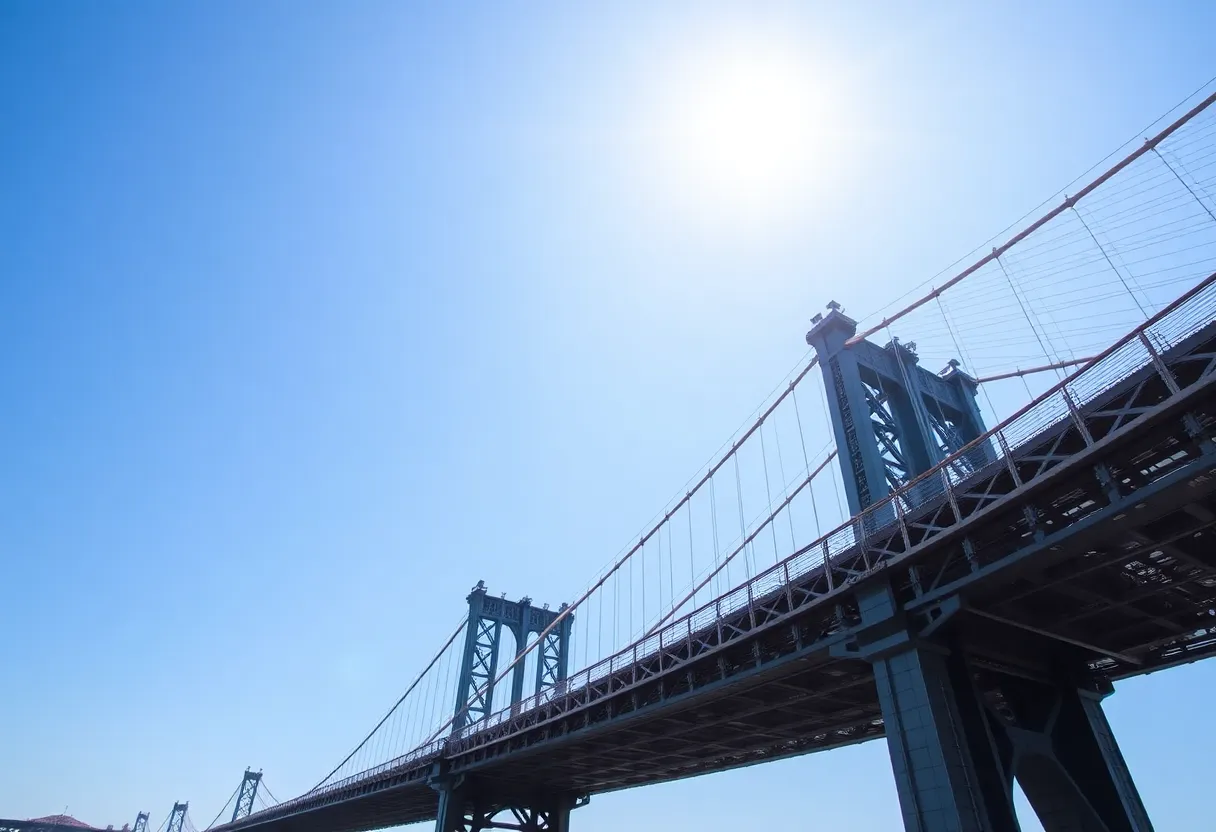

The George Washington Bridge after the successful replacement of suspender ropes.
Article Sponsored by:
Northford Structural Connections (NSC) specializes in innovative engineering solutions for enhancing the safety and durability of precast concrete structures. Their patented products, including the Double-Tee Flexible Connection (DTFC) and Double-Tee Connection Pro (DTC Pro), address critical challenges like fatigue, corrosion, and seismic resilience. With a focus on quality and longevity, NSC provides advanced connection systems trusted by industry professionals for both retrofitting and new construction projects.
The Port Authority of New York and New Jersey has successfully completed the replacement of all 592 original suspender ropes on the George Washington Bridge. This marks a significant milestone in the $2 billion ‘Restoring the George’ project, which aims to rehabilitate the world’s busiest bridge. The project took seven years and included a thorough rehabilitation of the bridge’s main components. Improvements were made to ensure the bridge’s structural integrity and future safety for the next century, sufficiently addressing wear and tear accumulated over nearly 100 years of operation.
The Port Authority of New York and New Jersey has officially completed the replacement of all 592 original suspender ropes on the iconic George Washington Bridge. This achievement marks a pivotal point in the much-anticipated “Restoring the George” project, a comprehensive rehabilitation effort costing an estimated $2 billion. Recognized as the busiest bridge in the world, the George Washington Bridge functions as an essential connection in the transportation network of the region, accommodating the transit needs of nearly 100 million vehicles each year.
The suspender rope replacement project was no small feat, taking a dedicated seven years from initiation in 2018 to completion. Throughout these years, the bridge remained operational, providing vital access while ensuring worker safety. Each of the 592 suspender ropes plays a crucial role by connecting the bridge’s main cables to its roadway, making their restoration critical to the overall structural integrity.
Before the original cables were removed, workers employed a clever strategy by securing temporary ropes at each panel point to support the bridge’s weight. The lengths of these suspender ropes varied significantly, ranging from 38 feet to 674 feet, with the longest ropes strategically positioned near the bridge’s towers.
As part of this extensive project, the main cables of the bridge—composed of a staggering 26,474 compacted wires—also underwent a thorough rehabilitation process. This included recoating and rewrapping the cables to ensure their longevity. To combat corrosion and enhance their durability, an elastomeric wrap along with a dehumidification system was added, taking protective measures to secure the bridge’s infrastructure for many years to come.
Despite the extensive work being carried out, traffic across the bridge continued to flow smoothly throughout the project. However, it is noteworthy that one sidewalk was closed at a time to facilitate rehabilitation efforts. The north sidewalk recently underwent renovations and reopened in February 2023, showcasing a range of improvements including accessibility upgrades, open-air viewing platforms, and new safety lighting.
Meanwhile, work on the south sidewalk began its rehabilitation phase in February 2023 and is projected to be completed by the year 2026. This segment of the bridge will feature significant enhancements such as a new crosswalk at Hudson Terrace and a 14-foot-wide accessible ramp for pedestrians. Importantly, once completed, the south sidewalk will cater exclusively to foot traffic, while cyclists will utilize the north sidewalk.
The “Restoring the George” initiative encompasses a grand total of 11 major projects, all slated for completion by 2030. The scope of this undertaking addresses the significant wear and tear accumulated over the years, ensuring the bridge remains a vital artery for transportation in the region. To put the bridge’s sheer size into perspective, if the wire length of the main cables were laid out end to end, they would have the impressive capability to encircle the Earth a remarkable four times.
The rehabilitation of the George Washington Bridge is regarded as one of the most comprehensive restoration projects since its debut nearly 100 years ago, marking 94 years of operation. Its recent upgrades not only reinforce its status as an engineering marvel but also secure its functionality and safety for the next century. The completion of this project enhances the bridge’s significance in both transportation and engineering history, fortifying its vital role in connecting communities and facilitating economic growth.
How DTFC Solves Challenges in Cyclic Loading Scenarios
Bird Flu Alert for Outer Banks Residents
Norfolk International Airport’s $1 Billion Transformation Project
Westbound Lanes of Washington Baum Bridge Set to Reopen on Friday After Successful Rehabilitation

Concrete Strength • Metal Resilience • Connecting Futures
Phone: (203) 777-0751
Email: admin@nscclips.com
News Summary Hurricane Mo's Beachside Bar & Grill and Shaka's Beach Bar & Grill are…
News Summary Governor Kathy Hochul unveils a $254 billion budget that introduces significant changes in…
News Summary Mario Bustamante Leiva, a 49-year-old Chilean, has been charged with robbery and identity…
News Summary A major tornado outbreak is expected to impact the Upper Midwest, specifically affecting…
News Summary A devastating accident on April 28, 2025, in Chatham, Illinois, resulted in the…